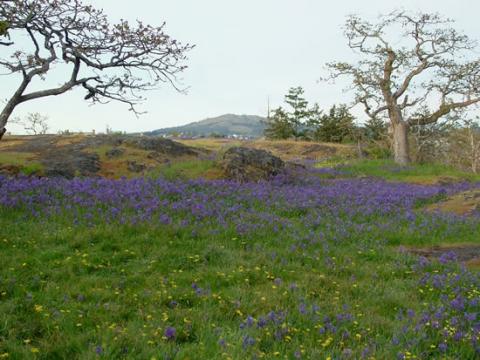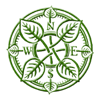
Points of higher elevation are significant for their panoramic views, their intriguing geological history, and their innate ability to instill significant memories and stories into those people who make the traverse to the top. The place popularly known as Knockan Hill has undergone several colloquial renamings but retained a similar sounding place name throughout time.
Geographically, this hill is located northwest of the City of Victoria, overlooking the Portage Inlet which connects Craigflower Creek, Colquitz River, and Hospital Creek to the Salish Sea via the Gorge Waterway. The hill’s highest point of elevation is 82 metres above sea level, which sits approximately 800 metres from the edge of Portage Inlet as the crow flies (CRD Atlas 2011).
The first colonial reference to the name “Knockan Hill” appeared on an 1885 J.D. Pemberton map of Southeast Vancouver Island (Brown et al 2008). The Gaelic word “Gnocan,” meaning knoll or hill, was said to be used by early Scottish settlers with reference to the hill.
 The area encompassing land from Pedder Bay east to Oak Bay and north to Cordova Bay, including Knockan Hill, has also been associated with the Lekwungen peoples (Lutz 2008). Today some of the Lekwungen peoples are referred to as Songhees and Esquimalt First Nations who identify with the Coast Salish language tradition.
The area encompassing land from Pedder Bay east to Oak Bay and north to Cordova Bay, including Knockan Hill, has also been associated with the Lekwungen peoples (Lutz 2008). Today some of the Lekwungen peoples are referred to as Songhees and Esquimalt First Nations who identify with the Coast Salish language tradition.
The first written record identifying the hill as significant to indigenous peoples was by Robert Brown, a Scottish botanist who describes the legend he titled The Indian story of Jack and the Beanstalk. It contains many geographic references that clarify the location, including Elk Lake and The Gorge, and he names “Knochan” in the Tsongeisth language to mean “coiled up,” referring to the significant role of rope in the legend. The following is the legend, recounted by Robert Brown, who heard the story during his field work in the area:
Once on a time long ago (this was in the days no more remembered, when the heavens were nearer earth, and the gods were more familiar—it never happens nowadays), two Tsongeisth girls were gathering gamass,* at Stummas (near Elk Lake, Vancouver Island), and after the manner of the gamass-gatherers they camped on the ground during the season. One night they lay awake, looking up at the bright stars overhead, thinking of their lovers, and such things as girls, Indians or English, will talk about. The Indians suppose the stars to be little people, and the region they live in to be much the same as the world down below. As one of the girls looked up at the little people twinkling overhead, one said to the other, looking at Aldebaran, the red eye of the Bull, “That’s the little man to my liking; how I would like him for my lover!” “No,” said the other, “”I don’t think I should; he’s too glaring and angry-looking for me. I am afraid he would whip me. I would better like that pale, gentle-looking star, not far from him.” And so the gamass-gatherers of Stummas talked until they fell asleep. But as they slumbered under the tall pines, Alderbaran and Sirius took pity on their lovers and came down to earth, and when the girls awoke in the morning it was Starland, with their lovers by their sides, in the country up in the sky. For a while all went well and happily, until, after the manner of their race, they wearied to see the friends at Quonsung (“The Gorge,” in the Victorian Arm) and Checuth (Esquismault), and their gentle husbands grew sad at their melancholy wives. One day one of the sisters came upon the busily engaged in Starland, and she said, “What are you doing, sister?” “I am twisting rope,” she said; “a rope of cedar bark, by which to get back again to Quonsung. Come, sister, our husbands are asleep, help me.” So the sisters fell to work, and while their husbands slept they wrought, until they had twisted a rope long enough, in their opinion, to drop themselves down to earth again. This they concealed in the woods, and then commenced to dig a hole in the vault of heaven with a pointed stake. For many days they dug, until they heard a hollow sound, and then they knew that they were nearly through; and the next day they finished their work (at a fitting time), and saw the clouds beneath, but the earth was a long way down. All this time their husbands were out hunting, or asleep in the lodge. They then fastened a stick transversely over the hole, and to this they attached the rope, and commenced to slide down. For long they slid, but yet did not come to the earth, and they began to fear for the results, for the rope was nearly ended, but Satitz (the east wind) took pity on them, and blew them to earth, and they knew not what happened, but on recovering their senses they found themselves near the valley of the Colquitz—not far from their own home—with the rope lying beside them. So they coiled it up and Haelse made it into a hill as a monument, to remind mortals not to weary for what is not their lot. And after this the girls went back to Quonsong, and became great medicine-women,* but remained single, all for love of the “little people” above. The stars, however, are gentle little folks, and were not at all angry with their wandering brides, and used often to visit them on earth again, when Seam Seakum (my lord the sun) has ended his travels over the great plain of the earth, for See Seam, my informant told me, “don’t you often see at the stars coming to earth?” and as he referred to the “falling stars,” I bethought me that the philosophers of “King George’s Land,” while giving no more sensible explanation of that phenomenon, had given one which appealed not half so well to the imagination. … “Knochan Hill,” the scene of the Tsongeish adventure, which they describe as the rope coiled up, is the eminence at the head of the “Victorian Arm,” and means, in the Tsongeisth language, “coiled up.”
Another narrative was from Franz Boas in September 1886, recorded during his journey of the North West Coast. Boas transcribed the hill’s name as a Northern Straits Salish term Ňgāˊk·un or phonetically ŋεˊˀqən, possibly derived from sŋεˊnət meaning "rock; mountain," or ŋεˊqə meaning "snow on ground" (Boas 2006[1886]: 170). Boas transcribes a similarly-themed legend from a Lekwungen “mythteller” titled The Wives of the Stars (See Appendix D).
These stories both contain evidence of the ecological and cultural significance of the hill for the women who collected Camas (Camassia sp) or wild onions (Allium cernuum and A. acuminatum) on the slopes of the Garry oak meadow (Quercus garryana), as well as its proximity to The Gorge and neighbouring villages (Boas 2006[1886] and Brown 1873). Of course, this place would also be culturally significant as a location to tell these stories that pass on important life lessons to future generations. Additionally, it illustrates the deep connection with the universe, and the worldview unbounded to Earth alone. Although the inferred lessons are different in each story, both express the intent of humbleness and gratitude for what one has.
Contemporary cultural significance still exists with modern First Nations women as many continue to harvest the Camas or wild onions on open meadow slopes such as those atop Knockan Hill (Bryce 2006). The hill is now blanketed with nine protected hectares of municipal parkland. The majority is covered Garry Oak woodlands, an endangered ecosystem, highly biodiverse, and pre-colonially maintained by the First Nations for thousands of years. The Garry Oak ecosystem provides a sense of place and regional identity for residents, and the ecological and cultural value of this landscape has been recognized historically by Captain George Vancouver as well as contemporarily by the City Council as “our foundation native species” (Erickson 1993).
Even as I stood atop Knockan Hill in the rain and wind over a dreary September weekend, the overwhelming beauty of the inlet view and twisting oak branches made this hill feel significant and I could feel as though I understood why such a magnificent place would have such an engaging narrative.
References
- Boas, F., Bouchard, R., Kennedy, D., & Bertz, D. (2002). Indian Myths & Legends from the North Pacific Coast of America: A translation of Franz Boas' 1895 edition of Indianische Sagen von der Nord-Pacifischen Küste Amerikas. Vancouver: Talon Books.
- Capital Regional District. (2011). Regional Community Atlas Viewer. Retrieved September 26, 2013 from https://maps.crd.bc.ca/
- Brown, R. (1873). The North-Western American Indians. In The Races of Mankind: being a poplular description of the characteristics, manners and customs of the principal varieties of the human family (pp. 131-132). London, England: Cassell, Petter and Galpin.
- Brown, A., Pevec, Z., Reynolds, I., Wang, L., Yacura, D. (2008). A Study for a Management Plant for Knockan Hill Park. Victoria: One Planet Consulting. Retrieved September 20, 2013 from http://www.knockanhillpark.ca/uploads/OnePlanetConsulting.pdf.
- Duff, Wilson. (1969). The Fort Victoria Treaties, BC Studies.
- Erickson, W. (1993). Garry Oak Ecosystems. Victoria: Ministry of Environment, Lands and Parks.
- Friends of Knockan Hill Park (2013). History of Knockan Hill Park. Retrieved September 26, 2013 from http://www.knockanhillpark.ca/history.php
- Lutz, J. S. (2008). Makuk: A New History of Aboriginal-White Relations. UBC Press: Vancouver.
- Penn, B. (2006). Restoring Camas and Culture to Lekwungen and Victoria: An interview with Lekwungen Cheryl Bryce. Retrieved September 21, 2013 from www.firstnations.de/media/06-1-1-camas.pdf
- Turner N., Turner K. (2008). Where our women used to get the food: Cumulative effects and loss of ethnobotanical knowledge and practice. Case study from coastal British Columbia. Botany 86: 103–115.


